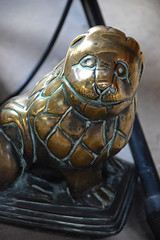| |
|
St Giles,
Norwich
 |
|
Here
we are to the west of the market place, along the
road which would eventually take us to the
Midlands if we let it. Now, Norwich is not short
of large, urban churches, but St Giles is a
little different to the others in that it is
almost entirely the work of the 14th century, and
is thus late Decorated in character rather than
Perpendicular. The porch and chancel are later,
contemporary with the other great city centre
churches that industrial wealth provided on the
eve of the Reformation, but given that the bulk
of St Giles is earlier than these other churches,
it is interesting to note that it stands on the
highest point within the old city walls, and its
tower is the tallest of any Norwich city church.
This tower was intended to be seen from afar, and
so from the start it is obvious to us that St
Giles was planned to be an important church.
Today, it is often known picturesquely as St
Giles-on-the-Hill. And still today St Giles
forms an important part of the townscape. The
nave floor is at the same height above sea level
as the famous roof bosses of the Anglican
cathedral, but it is the catholic cathedral that
St Giles sits close to, and in the absence of any
other towers in the immediate vicinity, Giles
performs a counterpoint to great block of a tower
of Scott's fabulous building. This may well have
been intended by Scott when he designed it,
although of course he could never have imagine
that the two would one day be doing their dance
from either side of the sunken inner ring road.
|
Diocesan
architect Richard Phipson was responsible for the
considerable restoration here at St Giles, rebuilding the
chancel completely in the style of the rest of the
church, replacing at last the former chancel which had
been demolished in the late 16th century. Late medieval
money brought a great stone south porch, which appears
fortress-like against the earlier flintwork and tracery
behind it. And perhaps not inappropriately so, for here I
must make a moan that, in common with several other of
the city centre's working churches, St Giles is usually
kept locked. Such a state of affairs would not be allowed
in the centre of Cambridge or Ipswich, and so it is a
shame that the diocese allows it here.
The
interior is almost entirely Phipson's work, a Victorian
church within a medieval shell, but what a shell it is.
The great fluted columns rise into dimness as if one were
walking through a great forest. Inevitably, there is a
similar feel to Phipson's St Mary le Tower in Ipswich
which retains similar arcades, except for the great
blessing here that most of the coloured glass in the nave
is gone, and St Giles is filled with light. Pevsner
records that the restoration cost five thousand pounds,
about a million in today's money, which likely included
the cost of rebuilding the chancel as well.
The
furnishings are a quiet counterpoint to the colours of
the Anglo-catholic fixtures and fittings, a liturgical
tradition which St Giles maintains, and which has
benefited from acquisitions from other Norwich churches
as they became redundant. There are earlier survivals,
including medieval brasses, the best of which are two
pairs to two couples, the Perdaunces and the Baxters,
both from the 15th century, and a chalice brass to a
former Priest.
| Best
of all, there is one of those enormous 15th
century East Anglian latten lecterns, an eagle
supported by little lions at the feet and a
dedicatory inscription of 1493. Nick Groves tells
me that it is the one that used to be in St
Gregory, and before that in St Michael Coslany.
Nick also recalls a story from the same decade
that the lectern was made. One John Colton was
lost in a storm outside the city, but was saved
by following the sound of the curfew bell being
rung from the tower of St Giles. In gratitude he
bequeathed a parcel of land, but also left a
small bequest for the curfew bell be rung from St
Giles' tower in perpetuity. This request is still
honoured every evening, an unusual example of an
instruction from before the reformation still
being carried out. The Norwich city churches
tend to wear their mayoral mace and sword rests
like trophies, a reminder of the Mayors provided
by the parish over the centuries. St Giles is no
exception, having no less than five sets of them.
And another reminder of the civic importance of
St Giles is the large number of generally very
good memorials to past worthies, especially of
the 18th and 19th century.
But
I am making it sound a stuffy, antiquarian place,
and it is not. Rather, St Giles has the feel of a
living church, and the occasions on which I've
visited I've always found it warmly welcoming -
at least, when I've managed to get inside.
|
|
 |
Simon Knott, March 2018
|
|
|
